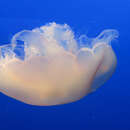Look Alikes
(
Inglês
)
fornecido por Invertebrates of the Salish Sea
How to Distinguish from Similar Species: The rare Aurelia limbata has profusely branched subumbrellar canals and the margin is dark brown. It is found off Alaska. Aurelia aurita is a very similar Atlantic and Baltic species which has 8 rather than 16 marginal lobes and has unbranched rather than anastomosing adradial canals. Until recently A. labiata along this coast were thought to be A. aurita.
- licença
- cc-by-nc-sa
- direitos autorais
- Rosario Beach Marine Laboratory
Distribution
(
Inglês
)
fornecido por Invertebrates of the Salish Sea
Geographical Range: Found in most seas, from the poles to the tropics. Includes seas off Europe, Japan, Gulf of Mexico, E. US. Probably not native to the Pacific Coast of N. America, but now can be found all along the coast at times. May have originally been from Europe.
- licença
- cc-by-nc-sa
- direitos autorais
- Rosario Beach Marine Laboratory
Habitat
(
Inglês
)
fornecido por Invertebrates of the Salish Sea
Depth Range: Shallow pelagic. Often washes up on beaches.
- licença
- cc-by-nc-sa
- direitos autorais
- Rosario Beach Marine Laboratory
Comprehensive Description
(
Inglês
)
fornecido por Invertebrates of the Salish Sea
This pelagic jellyfish has many very short tentacles, forming a fringe at the margin of the bell. It has 16 marginal lobes and 8 rhopalia. Each rhopalium has a small tentaclelike lappet on each side of it, and also has eyespots. The subumbrellar canals are branched and anastomosing. The oral arms meet at the center of the subumbrella, and extend beyond the bell usually with crenulated margins. Usually an opaque whitish, though sometimes with other colors. The conspicuous, horseshoe-shaped gonads are whitish or may be violet or pink or whitish or yellow. The margin is not brown. The bell is usually wider than high. Up to 40 cm diameter; usually 10-15 cm.
- licença
- cc-by-nc-sa
- direitos autorais
- Rosario Beach Marine Laboratory
Comprehensive Description
(
Inglês
)
fornecido por Invertebrates of the Salish Sea
Biology/Natural History: Abundance of this species varies widely seasonally and from year to year. Females of this species carry young larvae on the inner edges of the oral arms. Scyphistomae can sometimes be seen in large numbers attached on floating docks or on protected rocks in the lower intertidal, and are about 1 cm long when extended, with long tentacles. In central CA the scyphistomae are seen beginning in February and strobilate around March. In Washington they strobilate January to April. The medusae grow rapidly and are sexually mature by June. Most medusae die after reproducing but some live a second year. Polyps feed by predation like small anemones. The medusa feeds by capturing small organisms such as copepods on mucus, which is then moved to the mouth by cilia. The medusa seems to make little use of nematocycts in capturing food. Individuals of this species from cold waters can survive being frozen solid in ice. The species appears to migrate toward the surface during the day and downward at night. The umbrella pulsing originates in one of the eight rhopalia, and spreads via the nerve net. When starved, this species can shrink dramatically in size while retaining functionality. The tentacles of this species may trigger a slight rash. The species is sometimes eaten by blue rockfish Sebastes mystinus.
- licença
- cc-by-nc-sa
- direitos autorais
- Rosario Beach Marine Laboratory
Habitat
(
Inglês
)
fornecido por Invertebrates of the Salish Sea
Pelagic, inshore and offshore
- licença
- cc-by-nc-sa
- direitos autorais
- Rosario Beach Marine Laboratory

